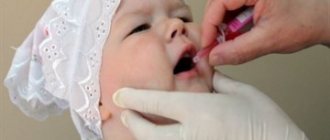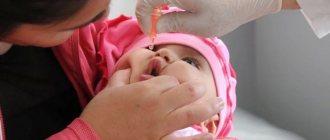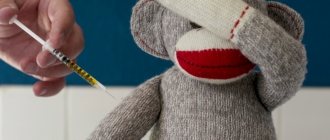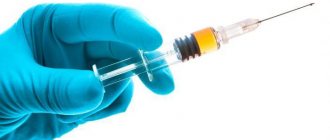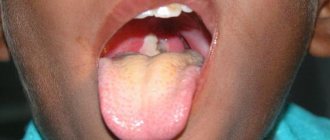After vaccinations, children often develop a fever. This indicates the presence of a response from the immune system in response to the introduction of the antigen.
Parents should not be afraid of hyperthermia when it is minor and no other complications have arisen. To know how to act in the situation, consult a pediatrician before vaccination.
Can the temperature rise
Polio vaccination is the introduction of suppressed inactivated strains of the disease. In response, the body releases antibodies that remember the genetic code of the infection. When a similar antigen re-enters the human body, infection will not occur.

Immediately after vaccination against polio, the state of health of most patients is stable, there are no negative processes. But after a few hours the body temperature may rise. This is a common reaction to the use of the vaccine.
The appearance of hyperthermia is associated with the production of antibodies that begin to fight the infection. If it is excessive, it may indicate complications.
There are 3 types of hyperthermia after vaccination:

weak (+37…+37.5 °C);- moderate (+37.5…+38 °C);
- high (+38 °C or more).
If the fever is low, this is normal. The child’s health deteriorates slightly, the baby becomes whiny and refuses to eat. But the next day the reaction should be completed.
If this does not happen, make an appointment with a pediatrician.
When the temperature rises to high levels, the patient should be given an antipyretic drug. A doctor is called to your home to determine the cause.
A high temperature is characteristic of a normal reaction when vaccinated with a suppressed strain of polio.
How is polio transmitted?
Polio can be spread through contact with contaminated feces (such as changing a diaper), airborne transmission, or food or water. The virus enters the body through the nose or mouth, then enters the small intestine, where it undergoes an incubation period. It then enters the bloodstream, where antibodies are produced against it. In most cases, this stops the progression of the virus and the individual gains lifelong immunity against the disease.
Many people mistakenly believe that any contact with the polio virus will result in paralysis or death. However, most often when infected with this disease, we will see only very few characteristic symptoms. 95% of those infected with the natural polio virus will not show any symptoms even during an epidemic.
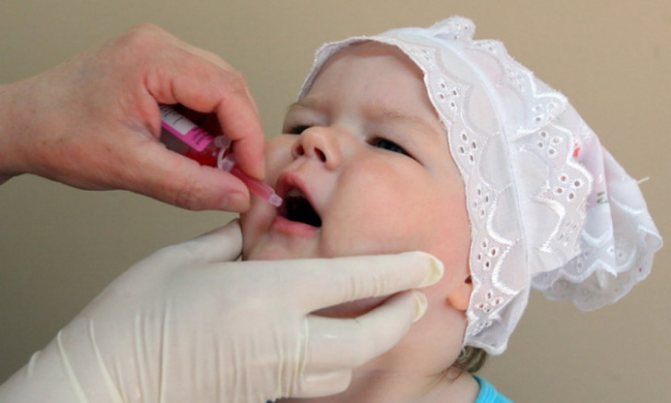
About 5% of those infected will develop mild symptoms such as sore throat, neck stiffness, headache and fever, often mistaken for a cold or flu. Muscular paralysis affects only one in a thousand people affected. This has led some scientists to conclude that in order to develop paralytic polio, one must have anatomical susceptibility to the disease. The remainder, the vast majority, may have natural immunity to the polio virus.
Injections. Studies have shown that injections (of antibiotics or other vaccines) increase susceptibility to polio. It has been known since the early 1900s that paralytic polio is often caused by injection. When in the 1940s. Vaccinations against diphtheria and whooping cough were introduced, and cases of polio increased sharply (graph 1).
These data were published in the Lancet and other medical journals. In 1949, the UK Medical Research Council established a committee to study the causes of this phenomenon. During the committee's work, it became clear that within 30 days after the injection the individual is at increased risk of paralysis; injections alter the distribution of paralysis; the type of injection (subcutaneous or intramuscular) does not matter much.
Is it normal to have a fever?
Only mild to moderate hyperthermia is considered normal..

The second option appears rarely and has the following consequences:
- suppuration in the area of injection;
- abscess, cyst;
- addition of an additional infection, virus;
- the spread of polio throughout the body because the immune system cannot cope with it.
The state time is counted. It should return to normal on the second day.
If hyperthermia gradually increases, in addition to taking an antipyretic drug, it is recommended to take a general blood test and conduct other tests.
Care and methods to prevent infection
The basics of care and prevention of polio in the outbreak can be presented in several theses.
If obvious signs of illness are detected, parents need to call a doctor, and if the disease is confirmed, help doctors identify everyone who had contact with the patient. Isolate the patient for 21 days, and those in contact for 20 days.
For those who have been in contact, quarantine is lifted earlier if there are no new cases of the disease. If a family has several children, they are monitored. Feeding sick children must be done carefully, as swallowing may be impaired. After recovery and during the period of residual effects, dose the loads, strictly follow the recommendations of specialists in physical therapy.
Causes of temperature
Physiological reasons why hyperthermia occurs:
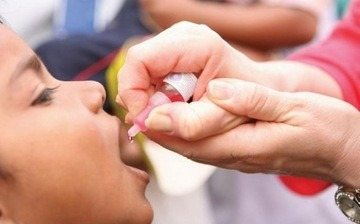
use of live vaccine;- a slight decrease in immune resistance to invading viruses;
- a protective response when an antigen is introduced, which means the release of antibodies against the virus;
- patient fatigue, lack of sleep, heavy physical activity.
The condition occurs for the following pathological reasons:
- vaccination during the period of infection with infectious diseases, which significantly weakens the patient’s immunity;
- immune deficiency;
- infection with polio with the spread of infection through the blood and the development of clinical symptoms;
- the appearance of an allergic reaction that is dangerous to life and health, a high risk of systemic disorders (anaphylactic shock, urticaria, Quincke's edema);
- local inflammatory reactions on the skin due to improper administration of the product (lack of antiseptic);
- inflammation of the epidermis due to suppuration, abscess or cyst formation.
In a pathological process, hyperthermia can occur instantly. This indicates the presence of an allergic reaction. The child is given an antihistamine.
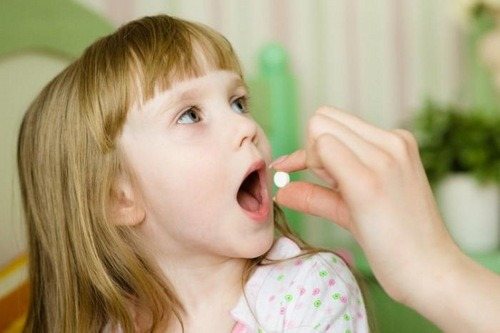
If the cause of hyperthermia is different, the temperature increases gradually. When the vaccination is done in the morning, fever often appears in the evening.
Live polio vaccine: roulette for parents
Recently, the Ministry of Health and Social Development decided to replace the inactivated polio vaccine with a “live” one. It is she who will now vaccinate six-month-old children. Many parents are panicking. Live vaccines already do not enjoy their trust, but then there is the live polio vaccine, which, as every informed parent knows, can cause real polio. What could such a change in the national vaccination calendar lead to and why was it made?
The Ministry of Health motivates the need to replace the “killed” vaccine with a live one by the fact that polio returned to Tajikistan, which borders Russia, in 2010. There were more than 700 cases and 26 deaths from polio. In addition, in the same year, 2010, one person died from polio in Russia. And this despite the fact that since 2002 the entire European region has been declared free from this disease. This means the virus has not been defeated. The returned polio is not ordinary, the Ministry assures, but “wild”. Vaccination with a live vaccine should help children develop immunity against this particular strain of the polio virus.
According to the current vaccination schedule, in the first year of life, children are vaccinated against polio at three, four and a half and six months. All three vaccinations are done with IPV - inactivated polio vaccine. Inactivated means rendered harmless by chemical or physical means. This in turn means that the virus from the vaccine cannot cause disease. Its task is to form immunity against the disease. The live vaccine (OPV - oral polio vaccine) also contains the virus, but not killed, but greatly weakened. This is precisely what allows us to talk about the potential danger of a live vaccine, because the virus is actually alive in it. The Ministry of Health prescribed this vaccine to vaccinate children at six months. “Any live vaccine is a disease,” comments Alexander Saversky, president of the League of Patients. And how this half-baked little animal will behave in a child’s body is unknown.” In addition, the expert notes, nothing is known about this vaccine: “Whether there were clinical trials, what their results were, we don’t know anything, and this quite naturally raises concerns.”
In addition, quite legitimate bewilderment arises. If in 2009 there was a conscious transition to an inactivated vaccine, then this happened for a reason. As Orthodox doctors write in the recently published brochure “Should Children Be Vaccinated?”: “In very rare cases, in people with impaired immunity, the viruses included in OPV can cause vaccine-associated paralytic poliomyelitis - both in vaccinated people and in people who have been vaccinated. in contact with them. Therefore, since 2008, the vaccination course for infants has been carried out only with IPV, and OPV is used for revaccination. After the transition to immunization with an inactivated vaccine since 2009, not a single case of vaccine-associated paralytic poliomyelitis has been registered in Russia (over the previous 10 years, an average of 11 cases were registered per year).” Eleven people got sick out of hundreds of thousands of people vaccinated. The number is small. But enough to worry parents and doctors. Now the threat is returning.
Many doctors assure that there is no reason to worry. Thus, the first deputy head of the United Russia faction, member of the State Duma Committee on Health Protection, Honored Doctor of the Russian Federation, Doctor of Medical Sciences, Professor Tatyana Yakovleva, noted that during the epidemic, and in the case of Tajikistan, the outbreak of polio is called exactly that, the recommended live vaccines. “They promote the rapid development of immunity and are more stable,” comments Yakovleva. But the expert emphasizes that this measure is temporary and was introduced solely due to the worsening epidemiological situation. “In rare cases, some pediatricians confirm side effects: for example, flaccid paralysis is observed, then quickly passes.”
An immunologist from the Privivka.ru hotline, when asked about the dangers of a live vaccine, answered: “If you give the first vaccination with a live vaccine, then there is a risk of post-vaccination complications or polio. But if the first two vaccinations are done with an inactivated vaccine, there is nothing to be afraid of. The child already has immunity.” That is, doctors recognize a certain danger of live vaccination, but bow their heads before the danger of an epidemic.
But some experts are sure that the epidemic has nothing to do with it. “Most likely, they are simply saving money on children,” says Pavel Vorobyov , deputy chairman of the formulary committee of the Russian Academy of Medical Sciences. – People get sick from a live vaccine. Not on a national scale, of course. And not fatal. But several dozen children will definitely get sick. Personally, I don’t understand the transition to an unsafe vaccine when we have many years of experience successfully using a safe one.”
But even money may not be the main reason here, says Vasily Vlasov , chairman of the Society of Evidence-Based Medicine Specialists. “They won’t save much on six-month-old babies. The cost of an inactivated vaccine compared to the cost of a live vaccine is, according to various estimates, 2-4 times more. Even if we take the maximum, it turns out to be less than 300 million rubles a year.” Vice-President of the Society of Evidence-Based Medicine Specialists, Kirill Danishevsky , proposed in this regard that the saved money should be transferred to children affected by the live vaccine and noted that the epidemiological threat is exaggerated.
The epidemic in Tajikistan does not threaten us, money has nothing to do with it, what else could be the reason for replacing the vaccine? “Russia has its own vaccine production,” says Vlasov. – It can only make live vaccines. Therefore, everything is simple - the fight for domestic producers. And the outbreak of polio in Tajikistan is only a reason for the redistribution of resources.” Saversky also agrees with the expert: “This is another attempt to replace a foreign drug with a domestic one. But last year’s experience with one of the drugs against multiple sclerosis, which was replaced by a domestic one and which affected more than 170 patients, is alarming.”
But the average parent, as a rule, is of little interest in what reasons, economic or political, his child will be vaccinated with another, more dangerous, vaccine. He is more concerned about whether or not his child will escape the fate of becoming one of the eleven people who get polio as a result of vaccination. And officials invite parents to play this roulette. True, they suggest taking precautions. “Before vaccination, you should consult with a neurologist; you should check with your pediatrician for all the information about the drug, familiarize yourself with possible contraindications, and tell about any disturbing symptoms - for example, the baby’s restless sleep,” advises Tatyana Yakovleva. And the decision whether to vaccinate or not is, as always, in the hands of the parents. In the end, you can buy an inactivated foreign vaccine and get vaccinated with it in a private clinic. Only if earlier this vaccine was paid for by the state, now it will be paid for from the parents’ wallet.
Diana ROMANOVSKAYA
How many days does it last
The duration of hyperthermia depends on the following indicators:
- individual reaction of the body in response to the introduction of an antigen;
- sensitivity of the immune system, allergies;
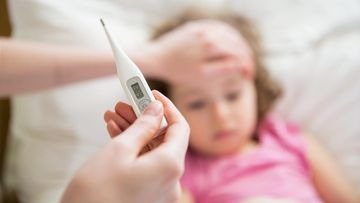
mild, moderate or severe hyperthermia;- correct administration of the drug, hygiene;
- the presence of other acute and chronic diseases affecting immunity;
- the addition of concomitant diseases immediately after vaccination or 1-2 days before it.
If health is normal, the immune system develops correctly, and there are no other diseases, then mild hyperthermia lasts for the first 24 hours.
In case of individual sensitivity to the components of the product, it can persist for up to 5-7 days. Usually the indicator does not exceed +38 °C.
If a complication occurs, the presence of another disease or allergy, the indicator can reach high levels, and hyperthermia lasts a long time. It does not go away until the pediatrician provides treatment.
What temperature after vaccination is considered normal?
The normal variant includes only 2 values: a weak or moderate increase in the indicator. This is the result of the action of immune system cells in response to the introduction of the virus.

Moderate values occur with minor failures. For example, slight inflammation of the skin, increased sensitivity.
The normal course of the process is indicated by a gradual improvement in the patient’s well-being and a daily decrease in the reading on the thermometer .
More often, the temperature drops 1 day after vaccination.
Is it necessary to lower the temperature?
If the indicator does not exceed +38 °C, you should not lower the temperature, because this leads to a decrease in the body’s resistance to the administered antigen.
Minor hyperthermia is needed to eliminate the influence of the virus and normalize the body’s condition.
At higher temperatures, antipyretics are given. This can be done every 4 hours.
If a child vomits after taking the drug, it is forbidden to give the drug again. This will lead to a sharp drop in body temperature (below +36 °C), a decrease in blood pressure, and loss of strength.
General information
Poliomyelitis is a highly infectious viral disease primarily affecting young children and is caused by one of three serotypes of poliovirus (1,2 or 3). It affects the nervous system and can lead to general paralysis in a matter of hours. The virus is transmitted from person to person primarily through the fecal-oral route or, less commonly, through some common carrier of infection (for example, contaminated water or food) and multiplies in the intestines. Many infected people have no symptoms but shed the virus in their feces and can thus transmit the infection to others.
Methods for reducing temperature
To eliminate fever, they use medications or traditional medicine methods.
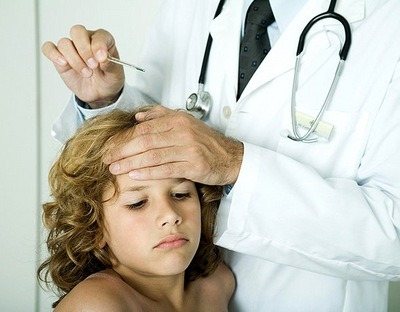
It is recommended to first ask your doctor which method is best. The child’s health status, allergies and other chronic diseases are taken into account.
Antipyretics
It is recommended to use drugs to eliminate fever only for hyperthermia above +38...+39 °C. The patient's condition worsens and the risk of dehydration increases.
Pediatricians advise using medications depending on the patient’s age:
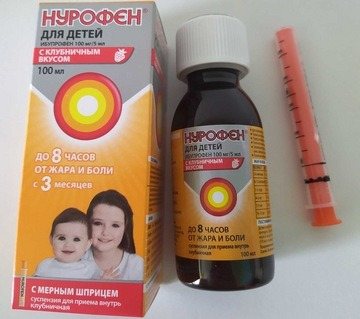
children under 3 years old - syrups (Nurofen);- children over 3 years old, adults, people suffering from allergies - tablets (Ibuklin, Paracetamol).
The volume of the drug given depends on body weight. All dosages are indicated on the drug packaging.
When using tablets or syrup, look at the packaging; it should indicate that the dose is suitable for children.
If the temperature does not go down for more than 4 hours, use 2 methods:
- injection with a lytic mixture;
- simultaneous use of Suprastin, No-shpa, an antipyretic drug.
These methods eliminate vascular spasm, so the active ingredients of the drug quickly penetrate the bloodstream, reaching the thermoregulation center of the brain.
Traditional methods
Traditional therapy methods are used for moderate hyperthermia.
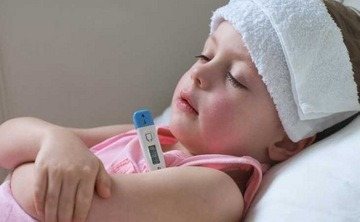
Recommended use:
- ventilation of the room to reduce the ambient temperature;
- removing the child's clothing to cool the body;
- copious amounts of water without gases;
- rubbing the arms and legs to restore blood flow.
It is forbidden to use alcohol rubbing; ethanol is absorbed through the skin, penetrating into the blood.
What means to use to lower the temperature
There is a wide range of different antipyretics for children; only a doctor can prescribe specific ones. If it rises above the permissible norms, then medicine recommends rectal suppositories Panadol and Cefekon D. Suppositories are much better than syrups and tablets. The child may burp the first ones and they will not work, and with tablets there are big problems when swallowing. Baby suppositories are approved for use from the age of two months; the active substance is absorbed into the blood in doses, which minimizes the risks of overdose
Another advantage of suppositories is that they do not have a toxic effect on the liver, which is very important for a young, weakened body.

"Cefekon D"
Syrups can be given only in exceptional cases when the temperature rises above +39°C. They act much faster than suppositories, lowering the temperature an hour after administration. During treatment, you must strictly follow the manufacturer's recommendations specified in the instructions. You are allowed to drink syrup up to four times a day every six hours, but no more than three days in a row. In difficult cases, the doctor may prescribe nimesulide; it has anti-inflammatory and antipyretic effects.
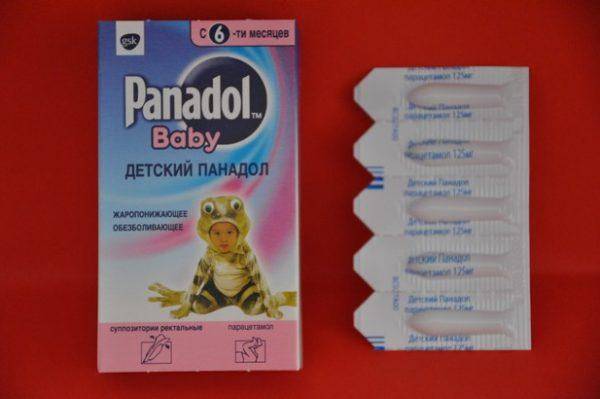
Panadol candles for children
When to see a doctor
It is recommended to call a doctor in the following cases:
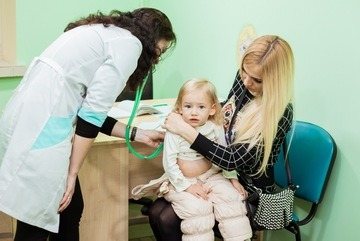
lack of effect from antipyretic drugs for a long time;- hyperthermia in infants;
- development of an allergic reaction;
- deterioration of health, fainting;
- severe inflammatory reaction at the injection site;
- the formation of dyspeptic disorders in the form of nausea, vomiting (after drops).
The pediatrician will recommend additional tests and prescribe treatment.
Complications
When adverse reactions from the vaccine occur or parents do not eliminate hyperthermia in a timely manner, complications will arise:

seizures with damage to part of the brain, development of neurological disorders;- spread of infection in the body; infection with polio;
- fainting;
- severe allergic reaction in children, leading to anaphylactic shock, Quincke's edema, urticaria;
- infectious infection with further suppuration of the skin;
- necrosis (death) of tissue at the injection site.
To eliminate the risks, parents should know what to do in case of hyperthermia and other consequences.
The inactivated vaccine causes fewer complications.
Vaccine-associated polio in adults
Children vaccinated with OPV can cause illness in adults with a severely weakened immune system due to the development of a number of diseases, including AIDS, cancer, and when taking immune-suppressing drugs. Such persons should temporarily exclude contact with a child vaccinated with OPV and strictly observe the rules of hygiene, remembering that the fecal-oral route is the main route of spread of infection.
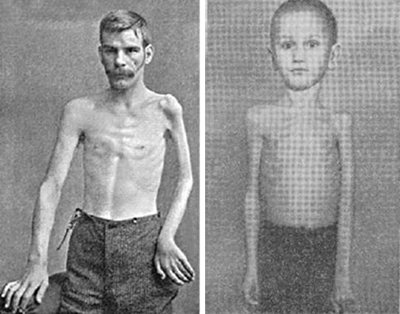
Rice. 3. Consequences of polio. Paresis of the upper limbs in an adult and a child.
Temperature prevention measures
Hyperthermia is a response to the vaccine in order to form full protection. But doctors recommend using the following rules to reduce the risk:

contacting a competent doctor who will administer the drug efficiently;- no walks for 2 days after receiving the vaccine;
- antiseptic treatment of the area of drug administration;
- the use of vaccination for children who do not have viral and infectious diseases.
If the child’s immunity is normally developed, the parents chose the right time for vaccination, the recovery procedure will be successful.
Effectiveness of vaccination
In 1988, governments created the Global Polio Eradication Initiative (GPEI) to rid humanity of the disease forever. Following widespread use of the polio vaccine, the incidence of the disease fell sharply in many industrialized countries. Since 1988, the number of polio cases has decreased by more than 99%, from 350,000 to 73 cases reported in 2015, according to WHO.
Just 20 years ago, polio caused paralysis in 1,000 children every day. In 2010, 1,349 children were paralyzed. This decrease was the result of global efforts to eradicate the disease. In fact, this is the largest peacetime mobilization of people in history.
In 2014, only three countries in the world (Afghanistan, Nigeria and Pakistan) remained endemic for polio; in 2015, Nigeria was removed from this list, while in 1988 the number of such countries exceeded 125. Failure to eradicate polio in these remaining persistent foci could result in up to 200,000 new cases of the disease occurring annually worldwide within 10 years. The world can be freed from the threat of polio if everyone commits to it - from parents to government workers and from political leaders to the international community.


